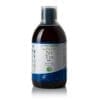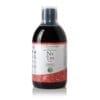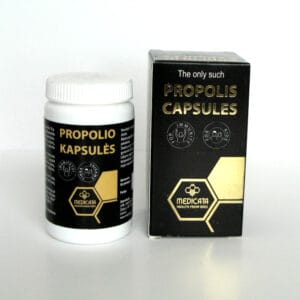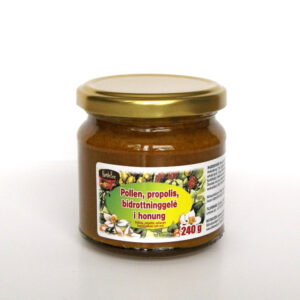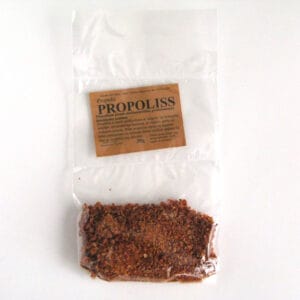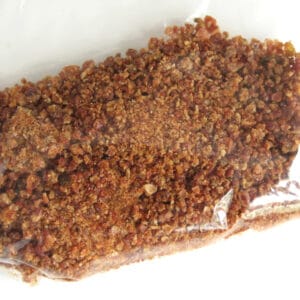NEW TIME WITH HERBS Effective Microorganisms Orgo-Germanika (33 strains of bacteria for the intestinal flora) 1 liter
Probiotics that contain valuable enzymes and microorganisms that naturally nurture the microbiome (intestinal flora) and create conditions for better intestinal function. A total of 33 bacterial strains! Based on natural and vegan ingredients, free from histamine, gluten, lactose, preservatives, synthetic flavorings and vinegar.
Available as 0.5 or 1 liter. Used for the stomach and intestines, immune system, general well-being, but can also help with certain fungal skin diseases and problematic wounds.
Use:
25ml/day before or with meals. When starting out, recommend 5 ml and increase the dose gradually, if everything feels good increase to full dose distributed in the morning and evening. Take in concentrated form or mix in a glass of water and drink before or with a meal. Store in the refrigerator after opening.
Also recommended for pregnant women. Used by both children and adults. Orgo-Germanika’s products are also very popular with psychiatrists, as they can often quickly bring about a better hormonal balance.
Ingredients:
Water, molasses*, sugars* (fermentation process via microorganisms consumes molasses and sugars); herb and plant/herb mixture (see below), fermentative microorganisms (lactic acid, yeast), probiotic microorganisms.
The herb and plant/herb mixture contains:
Pineapple*, angelica root*, anise*, basil*, dill seed*, fennel*, blueberry leaf*, raspberry leaf*, ginger*, cumin*, borage*, olive leaf*, oregano*, peppermint*, rosemary leaf*, red clover flower*, sage leaf*, black cumin seed*, licorice root*, thyme*, grape seed flour O.P.C.*, lacquer tick (Ling Zhi)*
* from organic farming.
Bacterial culture content (about 1 x 10,000,000.000 bacteria per 100 ml) bacillus subtilis; bifidobactrium animalis; bifidobacterium bifidum; bifidobacterium breve; befidobacterium longum; befidobacterium infantis; befidobacterium lactis; enterococcus faecium: Lactobacillus acidophilus; Lactobacillus amylolytikus; Lactobacillus amylovorus; Lactobacillus bulgaricus; Lactobacillus casei 01; Lactobacillus casei 02; Lactobacillus casei 03; Lactobacillus crispatus; Lactobacillus delbrueckii; Lactobacillus farraginis; Lactobacillus fermentum; Lactobacillus gasseri; lactobacillus helveticus; lactobacillus johnsonii; lactobacillus paracasei; lactobacillus parafarraginis; lactobacillus plantarum; lactobacillus reuteri; lactobacillus rhamnosus; lactobacillus salivarius; lactobacillus zeae; lactococcus diacetylactis; lactococcus lactis; saccharomyces cerevisae; streptococcus thermophilus.
During the production process, the bacteria metabolize a number of by-products, such as enzymes and various vitamins. The product therefore contains important nutrients such as vitamins B1, B2, B6, B12, K but also folic acid, biotin, niacin, pantothenic acid and others. All bacterial strains originally come from nature.
What is the difference between conventional probiotics and a bacterial supercomplex?
The established procedure when producing conventional probiotics is sequential cultivation of good bacterial strains, which are dried and then mixed. In the case of liquid products, sterilization is used or alcohol, surfactants, acetic acid or similar are added to make the product stable. Otherwise, only a few strains of bacteria would remain after a very short time. However, these bacterial strains never get used to each other and therefore cannot act as a supercomplex against other bacterial environments, successes are often short-lived. In Orgo-Germanika’s products, the mix is designed so that the strains live in harmony and synergy.
What are effective microorganisms (EM) ?
EM stands for ‘Effective Microorganisms’ and was discovered in Japan in the 1980s. It was quickly realized that EM are very useful in many different fields and that they can solve many of today’s health problems.
In Europe, EM is a fast-growing market, as more and more people discover it in different ways. In Scandinavia, it is mostly used for gardens, where EM is known through the so-called Bokashi composting. EM is introduced into the soil in liquid form or as fermented compost (Bokashi), where they create conditions that allow pathogens to be crowded out and increase nutrient uptake by plants and living organisms. They establish themselves at the roots of plants, as well as in the human gut, forming nutrients and making them available. This results in healthier plants that bear more fruit of better quality and are more robust.
Viktoria Skoglund from TV4 says that Bokashi is the best thing she has found. Sara Bäckmo from Skillnadens Trädgård has made several films about Bokashi and gets many views on Facebook.
Orgo-Germanika is primarily intended for the human environment, where EM competes with the bacteria that are unfavorable to us and thus provides relief for the body, the environment and nature. German medical doctor Anna Katherina Zschocke’s EM research and experience is the model for Orgo-Germanika.
EM will be a matter of course in many areas in the near future.
People, EM and the microbiome
The microbiome explains the totality of all microorganisms around and within us. They permeate all life and without them we could not live at all. They have many important functions, such as the production of vitamin B12. Neither humans nor plants can produce vitamin B12, it is the bacteria in our intestines that do it for us. If we lack these bacteria or if they are not sufficiently established, there is a deficit of vitamin B12. So the microbiome is extremely important for our nutrient absorption, immune system and health!
The nutritional supplement New Time consists of effective microorganisms and contains 33 different live bacterial strains. These partially probiotic bacterial strains have become accustomed to each other through fermentation and, as food supplements, can actively influence an established bacterial environment. Therefore, EM can hardly be compared to conventional bacterial or probiotic preparations as food supplements.
EM pioneer Dr. Zschocke describes how EM as a nutritional supplement can effectively support the immune system by treating different parts of the microbiome simultaneously, for example:
- Treating the air in your home
- Cleaning the home
- Washing the body
- Use it internally.
Effective Microorganisms (EM) are a mixture of different types of lactic acid, yeast and photosynthetic bacteria working together as a team.
There are three groups of micro-organisms. They have been present in nature since ancient times.
- A variety occurs where we see processes of decay and stench, mold, rust or some kind of disease.
- Another variety where there is purity, harmony, health, flowers or autumn leaves in the forest that decompose, and actually smell good.
- And a third group – the largest – which is neutral and adapts to help these microorganisms of the two varieties mentioned above, which dominate the site.
If there is an imbalance in one place and you add EM, it restores the balance. EM helps to break down substances wherever they are found, in soil, in the stomach, on the skin, and so on, so that these substances are converted into nutrients, among other things. Examples include vitamins B1, B2, B6, K, folic acid, biotin, niacin, pantothenic acid and even vitamin B12, which the body cannot produce itself.
EM and health
EM can be used in many different ways. In the home, for example, it is used for cleaning bathrooms, kitchens, furniture, windows, cars and as an air freshener, etc. By outcompeting the unfavorable bacteria, we create a clean and more favorable environment for our body, which is relieved of the unfavorable bacteria.
Anne Katherina Zschocke, MD, has been working and researching EM since the 1990s. She tells us about the different ailments people have gotten rid of after they started using EM. Today, she is among the foremost experts on EM. She has written six books on EM and is often commissioned by German television.
Bacteria / microorganisms are everywhere
Dr. Zschocke describes that bacteria are basically everywhere in nature. On the ocean floor, at lava outflows at thousands of degrees, or up in the sky at high freezing temperatures.
Yes, they are indeed everywhere and are masters at adapting in all conditions! Wherever they are, nature has a meaning behind it and they have a purpose. It is no longer a secret that bacteria have a superb ability to communicate with each other. For example, they can send out signals and attract earthworms from far away. If the bacteria adapt to new situations in one place, we soon discover bacteria on the other side of the world doing the same. Nature is once again showing its intelligence, but we still know almost nothing about this microlife (bacteria/microorganisms). We will learn more about this as science comes up with new discoveries in microlife almost daily.
At least 50,000 people die in German hospitals every year from resistant bacteria
These life-threatening bacteria have adapted to antibiotics (anti=against, bio=life = “against life”) and disinfectants. The rather harmless skin bacterium staphylococcus aureus was found in 1990 with less than 2% resistant to antibiotics. Today it is over 20% and rising. An international study shows that the proportion of infestations of these multi-resistant Gram-negative bacteria in intensive care units has increased from 39% (1992) to 62.2% (2007) – not far from 100%.
The history of working positively with bacteria
We should have realized long ago that we are working in the wrong direction. The history of fermentation, i.e. the purposeful use of bacteria to brew beer and make wine, is very old. The solution to the above-mentioned problem of resistant bacteria is to work with the bacteria and not against them. Anne Katherina Zschocke describes how inflammation disappears with the use of EM in this way.
One can hardly ignore the effectiveness and results of EM for over 35 years and which today is used worldwide, where many people have treated themselves on their own responsibility with success. One of these was the wife of the former German Prime Minister, the renowned medical doctor Veronika Carstens, founder of the ‘Natur und Medizin’ foundation, which publishes a magazine of the same name. In this magazine, she tells how she herself got rid of her pancreatitis by taking EM on a daily basis, and thus EM became known as a ‘healing agent’ in Germany.


